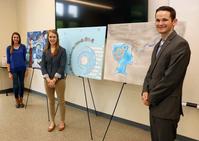Winners of 2017 "Beautify Grissom" art contest
IE students, faculty, staff, and the IE Advisory Council voted, and the winners were announced at a luncheon on April 28. Natalie Geraci won 1st place, Lily Bishop won 2nd place, and Nick Perkins won 3rd place. The winning paintings will be hung in Grissom Hall's Student Excellence Center. Congratulations, IE artists!
Natalie Geraci, 1st Place for "IE: The Optimal Path"
This canvas exemplifies what Industrial Engineering means to me by incorporating aspects of multiple industries and disciplines, especially those that I have been exposed to thus far. I used a clock as the focal point of the canvas that everything radiates from to emphasize the importance of time. Time is one of the driving factors that makes Industrial Engineers so crucial to every industry. Efficiency is driven most times by time reduction or process improvement, so I knew that had to be evident in my canvas. The cityscape signifies industry and business where Industrial Engineers have a significant presence. I included jets because all of my Industrial Engineering experience has been in the aviation industry, and my experiences there are what drew me to Industrial Engineering at Purdue. The arrows signify continuous improvement and the exchange of ideas. I also used half circles, gears and circuits to connect all of the components of the canvas; it was important to blend all of the sections to show how interconnected industrial engineering is with many disciplines and industries. Overall, there are many factors that go in to decisions that affect business and industry today, and Industrial Engineers play a major role in those decisions. They are behind the hard work in the inner circles that power the industries on the outer circle.
Lily Bishop, 2nd Place for "StarrIE Night"
My painting is based on Vincent van Gogh’s "The Starry Night", which has been one of my favorite paintings for years due to its incredible use of color and motion. I was inspired to base my painting on it because I saw it as a way to portray space travel in a dreamy, child-like way. I have been fascinated, ever since I learned what Industrial Engineering was, about the value IE can bring to the mission to put a human on Mars. To an IE, such a monumental task can be viewed as one extremely large system where every individual part must come together to achieve success. I took that idea, brainstormed a bit, and developed it into "StarrIE Night".
"StarrIE Night" employs minimal symbolism to get its message across. In the bottom right, Grissom Hall and Armstrong Hall are linked by a pathway, symbolizing the partnership between IE and other engineering disciplines that is necessary for a successful manned mission to Mars. Purdue’s bell tower and engineering fountain can be seen in the center. The fountain is decorated with therblig symbols, which represent the basic motion elements used by IEs to study motion and ergonomics in the workplace. Therbligs were created by Frank and Lillian Gilbreth, former Purdue professors and two of the founders of the IE discipline. Finally, in the upper right a space shuttle flies towards Mars. Physically inaccurate, yes, but a space shuttle is easily recognizable and added to the feeling of innocent excitement that I was trying to invoke. When fellow IE students look at "StarrIE Night", I wanted them to feel inspired to use their IE education to pursue their dreams, no matter how big, insurmountable, or ludicrous they may seem to others.
Nick Perkins, 3rd place for "Gilbreth"
This painting was inspired by Lillian Gilbreth, one of the first people to bring the industrial engineering discipline to Purdue. Gilbreth and her husband, Frank, were interested especially in the area of time and motion studies, or breaking down a task into its elements and analyzing the mechanics and safety of the job. The painting shows the silhouette of Dr. Gilbreth as an observer, watching a steel shaping laborer who happens to resemble the Purdue Boilermaker.The symbols which appear in the bottom right-hand corner of the paintings are “therbligs”, a term that Gilbreth coined herself, which (almost) happens to be her surname spelled backwards. A therblig is a symbol which represents an elemental motion in work analysis, such as grasping or holding. This represents Dr. Gilbreth’s profound impact on the continuous improvement of Purdue University. In addition to becoming Purdue’s first female engineering professor in 1935, she also taught in the areas of psychology and home economics, and was an inspiration to many young women of her time. Dr. Gilbreth also inspired those around her by her unwavering devotion to family life. She cared for twelve children; interestingly, she applied her time study research to improving efficiency at home. Dr. Lillian Gilbreth is an inspiration to Purdue for both her research contributions and personal character, and I hope that this can be reflected in this painting for Grissom Hall.
Challenge Question: 17 of the 18 recognized therbligs appear in this painting. Can you identify the one that does not?
Writer & Photographer: DeEtte Starr, starrd@purdue.edu

